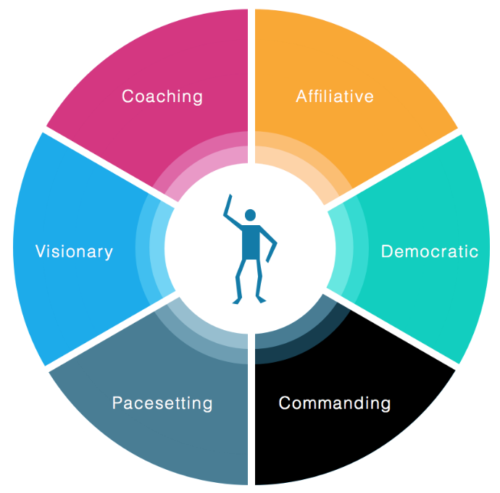Daniel Goleman’s Leadership styles is a classic management framework. Goleman may be best known for his bestseller, Emotional Intelligence, which demonstrated how the two minds – rational and emotional – are at play. It explained why some high IQ individuals fail and those with modest IQs do well. Emotional intelligence plays a significant role in success.
Goleman developed the Six Emotional Leadership Styles in a later book he co-wrote with Richard Boyatzis and Annie McKee, Primal Leadership. The best leaders, according to Goleman, possess the knowledge to understand leadership style and can apply the right leadership style for the situation.

Image Source: TES.com
The Six Emotional Leadership Styles
- Commanding
- Visionary
- Affiliative
- Democratic
- Pacesetting
- Coaching
The Commanding Leader
“Do as I Say”
When you see someone fitting this archetype, there’s no missing it. The Commanding Leader explains the mission and tells team members what to do. They expect employees to do the job and not question it.
It can be effective for short periods, but can lead to morale issues when used for extended periods. When there’s an urgent job to be done and there’s no time to discuss it fully, this may be the best option. The best leaders will take the time after the fact to explain the logic behind the decision and help teams understand why such a decision needed to be made.
Use Cases: During a crisis, dealing with problem employees, starting a turnaround, or pushing time-sensitive deadlines
The Visionary Leader
“Come with Me”
Visionary leaders understand the big picture and can communicate the message effectively. Not only can they communicate the goal and its importance, but they can also explain how each team member fits into achieving that goal and what they get out of it.
Visionary leaders take team members with them, get them excited, and motivate them to achieve. Empathy is a key skill to understand what motivates team members and what they need to feel successful. It can be difficult to achieve when team members have more experience than the leader without a demonstrated track record of success.
Use Cases: Changing directions, providing teams with clear direction, or rallying a team around a mission.
The Affiliative Leader
“People Come First”
The Affiliativee Leader works to solve (or avoid) conflict through collaboration. Under this leadership style, the leader tries to create harmony among team members so that everyone feels valued.
This style works best when the team isn’t creating the desire results because they are not working together efficiently. It can be difficult because the leader has to understand and take the emotions of the team members into the equation. The Affiliative Leader must develop and nurture positive relationships within the team by putting people first.
Use Cases: Healing teams, clear up misunderstandings, or motivate people during stressful situations
The Democratic Leader
“What Do You Think?”
The Democratic Leader also values team members by including them in the decision-making process. This takes high engagement from employees and trust in the team.
While urgent decisions may be best made by leaders based on experience, when there is time to make decisions, engaging the team in the process can generate several benefits, including buy-in to the final decision.
Use Cases: Situations that require significant change and team commitment, when you have knowledge gaps or need line-level expertise, or when you need input to make decisions
The Pacesetting Leader
“Do It at My Pace”
This leader is focused on high-quality work that leads to results. This style works best in highly-competent teams that are very engaged. The leader sets the tone and may lead the charge. Team members may work independently while the Pacesetting Leader tries to rally them to achieve even more. Follow my lead, they might say and expect others to keep up.
It works well for teams that can operate independently and need less oversight but can be difficult for high-touch team members to function effectively under this leadership style. It can also cause stress for employees that are managing complex and demanding assignments under deadline pressure.
Use cases: With highly productive teams, or when needing performance improvements to reach short-term goals
The Coaching Leader
“Try This”
The Coaching Leader focuses on the team’s development. By focusing on long-term goals and how employees help achieve these goals, this leader supports the team by providing coaching and training to help each member grow.
This helps build team competence by coaching weaknesses and nurturing strengths. It can foster a cycle of continuous improvement. As teams hit milestones, new goals are set and the coaching cycle can begin again.
Use Cases: Works with motivated employees who seek improvement, and for continuous long-term improvement
Daniel Goleman’s Leadership Styles – Which is Best?
As you can see, there’s no right or wrong management style under Daniel Goleman’s Leadership Styles. Successful leaders may use different styles at different times in a company’s development. They may use different styles with different individuals.
The best leaders are the ones that learn what their employees need and provide the right type of leadership at just the right time.
Other Classic Frameworks:
If you liked Leadership Styles by Daniel Goleman, please read about other classic frameworks by other famous authors and management thinkers.

